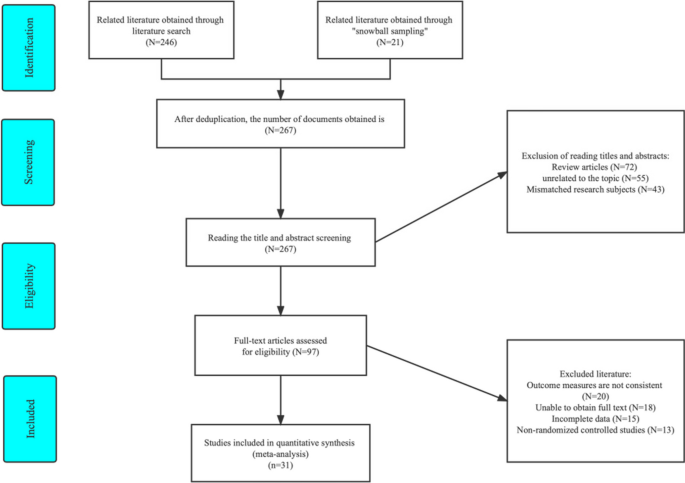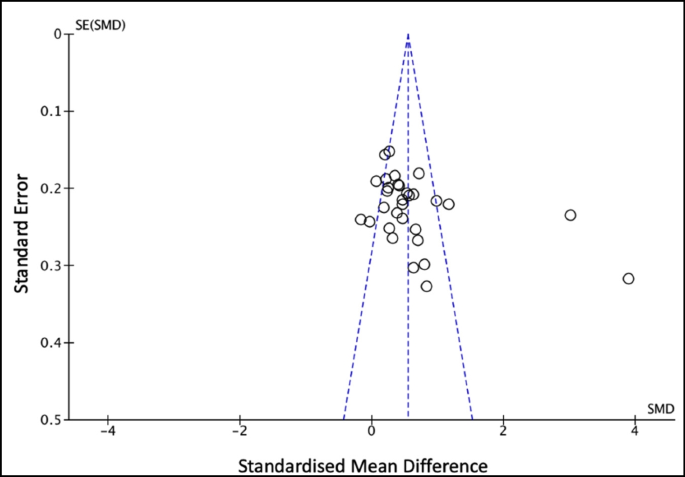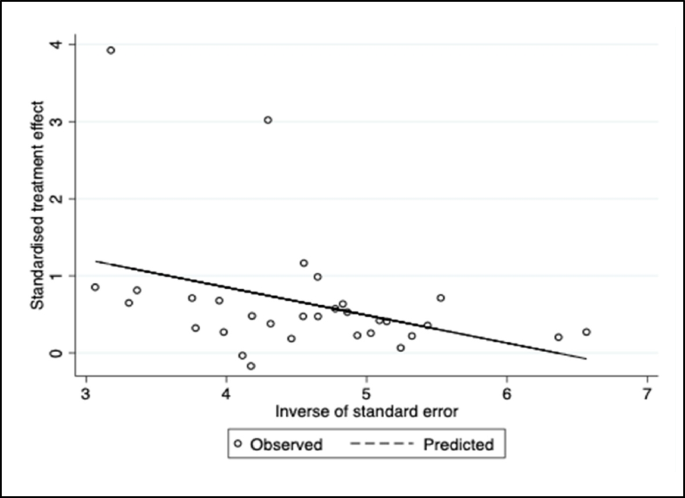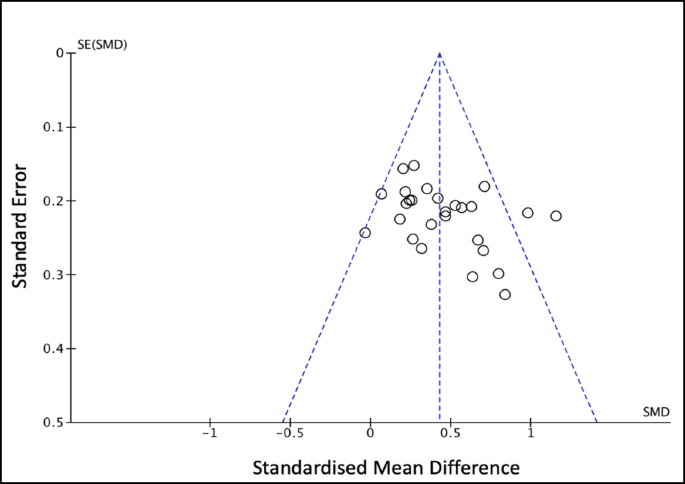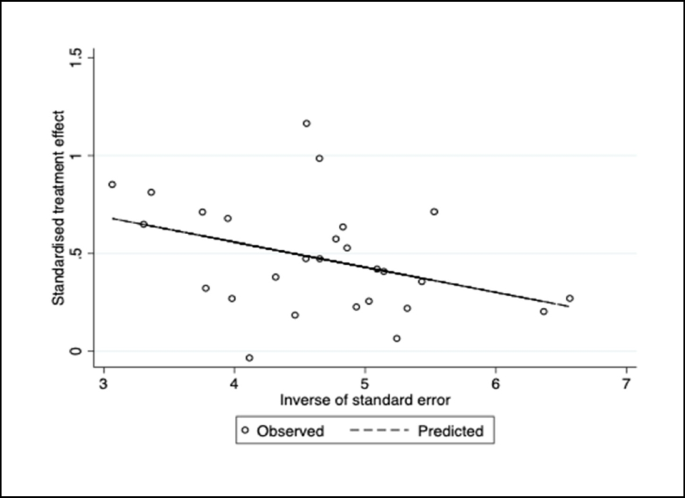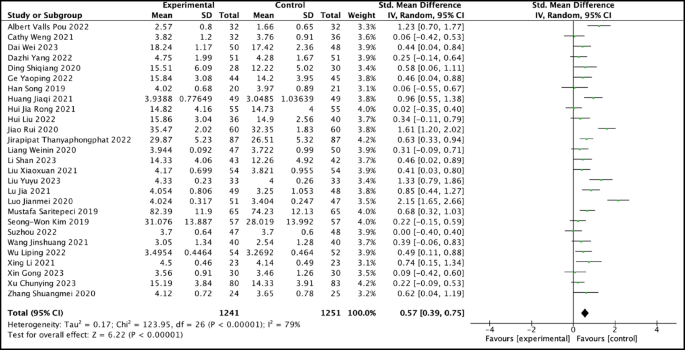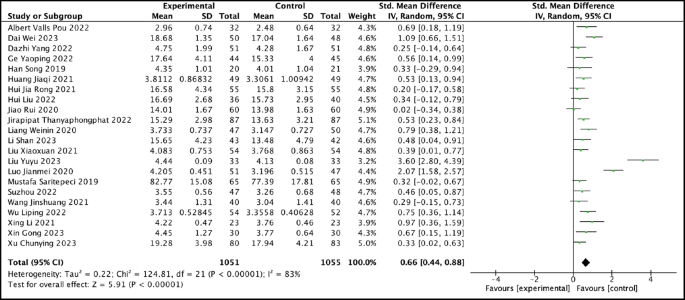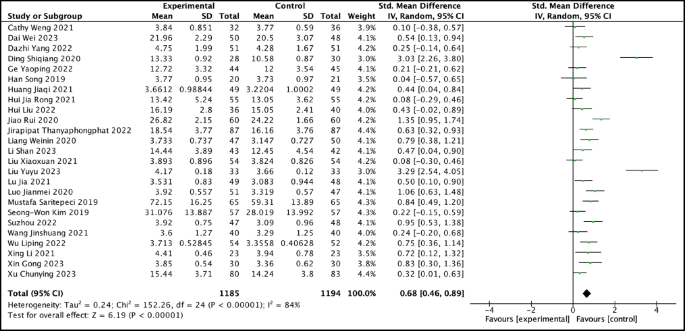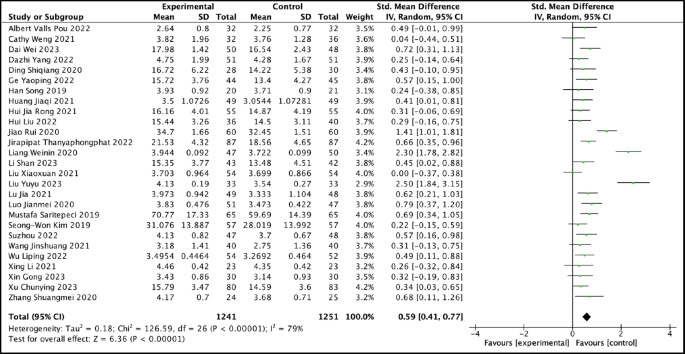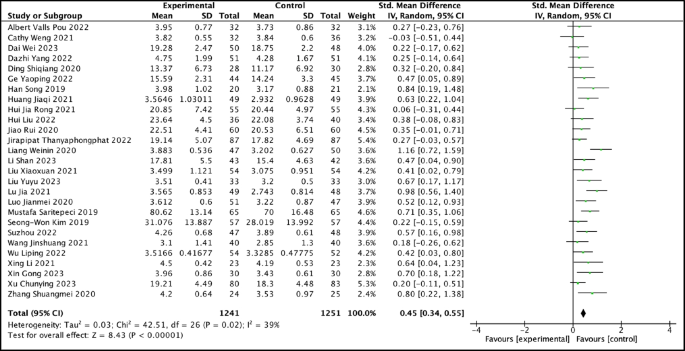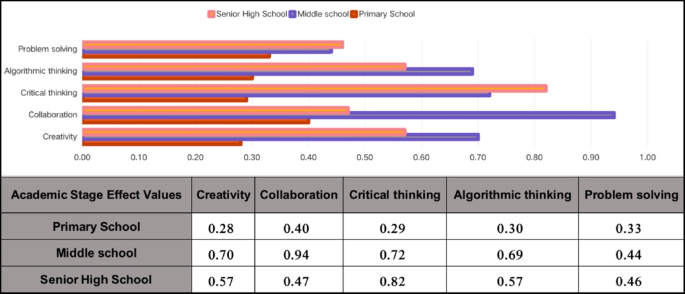Abstract
In the context of our rapidly digitizing society, computational thinking stands out as an essential attribute for cultivating aptitude and expertise. Through the prism of computational thinking, learners are more adeptly positioned to dissect and navigate real-world challenges, poising them effectively to meet the exigencies of future societal landscapes. The paradigm of project-based learning, heralded as a potent educational methodology, significantly amplifies students' prowess in computational thinking. To delineate the nuanced interplay between project-based learning and its augmentation of computational thinking, we engaged in meta-analytical investigations, synthesizing outcomes from 31 distinct external experimental and quasi-experimental studies. Our analytical journey underscored that project-based learning markedly elevates students' competencies across five critical spectra: innovation, collaboration, critical analysis, algorithmic cognition, and problem resolution. Dissecting its impact across the K12 continuum reveals that primary students predominantly hone their collaborative acumen; middle-grade learners witness a pronounced ascent in creativity, critical, and algorithmic faculties, while the apex of high school education primarily sharpens critical analytical prowess. Thus, educators sculpting the contours of project-based learning should be calibrate their strategies, ensuring they resonate with the developmental and age-specific nuances of their audience, to fully unleash its latent potential in nurturing computational thinking.
Similar content being viewed by others
Explore related subjects
Discover the latest articles, news and stories from top researchers in related subjects.Avoid common mistakes on your manuscript.
1 Literature review
1.1 Definition of computational thinking
The definition of computational thinking (CT) has undergone a developmental process, from its initial ambiguity to a later, more precise and comprehensive understanding. As early as 2006, Professor Yi-Zhen Zhou from Columbia University first proposed the concept of "computational thinking", defining it as "using the thinking style and fundamental concepts of computer science for problem-solving and system design, encompassing a series of cognitive activities that include thinking, understanding, and solving problems like a computer scientist" (Wing, 2006). This definition emphasized CT as a method of problem-solving, incorporating the cognitive style and basic concepts of computer science. Papert noted that CT involves not just knowing how to program but also knowing how to solve problems, and being able to decompose problems into smaller, manageable tasks for resolutio (Blikstein, 2013). This means a key component of computational thinking is the ability to break down larger problems into smaller, more manageable ones, and to represent solutions using programming languages (INTEF, 2018). This process includes generating an algorithm to solve the problem (Aho, 2012). Such a mindset shifts our role from being computational consumers to computational creators (Resnick et al., 2009). In her subsequent research, Professor Wing further refined the definition of computational thinking. She posited that it includes problem-solving, system design, recursive thinking for understanding human behavior, the use of abstraction and decomposition, and heuristic reasoning from a perspective of prevention and protection (Wing, 2019). Additionally, the International Society for Technology in Education (ISTE) in the United States offered a recent definition in 2018: CT is using the core principles and practices of computer science to solve vague, complex, and open-ended problems. The association also highlighted that CT, as a composite ability, includes creativity, algorithmic thinking, critical thinking, problem-solving, and collaborative thinking (ISTE, 2018).
Chinese scholars have also interpreted CT from various perspectives. Tracing back to the early 1990s, scholar Chongfu Huang first introduced the concept of "computational thinking" in an academic paper. He focused on the computational simulation of the thinking process, advocating that this process embodies CT. The core aim of the study was to construct a CT model utilizing the thought patterns of the computer and human brain, with the intention of accurately predicting and analyzing seismic events (Huang, 1992). Chen Wenyu and other scholars opine that CT is manifested particularly in formal language and automation courses, especially in formalized descriptions and abstract thinking capabilities (Luo et al., 2005). Zongli Jiang and others interpret CT from a different angle, viewing it as a human problem-solving method. They delineate the procedural methods we adhere to when contemplating how to utilize a computer to solve problems (Jiang, 2013). The "Ordinary High School Information Technology Curriculum Standard (2017 edition, revised in 2020)" issued by the Chinese Ministry of Education in 2017 adopted this understanding, defining CT as "a series of cognitive activities that arise in the process of constructing problem-solving solutions" (MEPRC, 2018). This thinking method requires students to solve problems creatively, to use the methods and ideas of computer science to analyze problems, to mathematically model the problem-solving process in order to form solutions, and then to solve the problems by writing computer programs and algorithms. It also necessitates the ability to transfer the strategies and methods of problem-solving. The connotation of CT includes two main aspects: on the one hand, it's the ability to solve problems using computer tools, not limited to the field of computer science; on the other hand, it represents an inherent expression of problem-solving methods, an organic unity of various types of thinking, including problem analysis capabilities, abstraction abilities, summarization abilities, algorithmic thinking skills, structured problem decomposition abilities, etc.In the field of educational research, particularly in the study of computational thinking (CT), there has been a noticeable trend towards the implementation of project-based learning (PBL) in practical teaching scenarios. These studies have demonstrated the significant impact of PBL on enhancing student engagement and learning outcomes. However, a critical observation is that the majority of these studies have been narrowly focused on specific teaching methodologies, thereby not providing a holistic view of the diverse impacts that different PBL practices might have on the cultivation of CT skills. This current study addresses this gap in the literature by employing a rigorous meta-analysis methodology. Our objective is to offer a comprehensive assessment of the influence of PBL within various educational settings on the development of CT.Our investigation encompasses a broad spectrum of teaching methods, ranging from traditional instructional approaches to more innovative, project-based strategies. We place a particular emphasis on the latter, delving into how project-based teaching methods can effectively nurture and enhance computational thinking skills among students. By adopting this approach, our study contributes a more expansive perspective to the existing body of knowledge. It aims to assist educators in comprehensively understanding the effectiveness of diverse PBL methodologies. This understanding is crucial for the development of various dimensions of computational thinking, thereby providing valuable insights and guidance for future educational practices and research initiatives.
1.2 Computational thinking education
As a key to future societal development, CT is receiving increasing attention globally, especially in the field of education. Studies suggest that encouragement for the creation of new teaching curricula (INTEF, 2018;Manches & Plowman, 2017;Micheuz, 2008), suited to different age groups and types of learning processes, is evident both at the level of educational policy and among academic researchers (Angeli & Valanides, 2020; Balanskat & Engelhardt, 2015; Brennan & Resnick, 2012). These fresh curriculum design concepts and practices have opened new pathways and models for learning CT in K-12 education, positively influencing the entire educational industry. For example, England, Australia, and New Zealand have officially integrated CT into their curriculum systems. Similarly, countries like the United States, Singapore, Nigeria, and Turkey are promoting computer science learning methods (Atun & Usta, 2019; Bocconi et al., 2016a, 2016b; Igbokwe, 2015). As for Europe, countries such as Sweden and Finland have proposed interdisciplinary strategies, while Denmark and Norway have added specific courses related to computational thinking (Bocconi, 2018). These developments indicate that computational thinking education has become an important trend in global educational development.Furthermore, China's emphasis on computational thinking is increasingly evident. Firstly, the development of information technology education in primary and secondary schools shows a shift from focusing on operational skill training to computational thinking training (Cao, 2018). The "Ordinary High School Information Technology Curriculum Standard (2017 Edition)" has clearly listed "computational thinking" as a core competency in the high school informaaation technology discipline (MEPRC, 2018). Secondly, China has emphasized the cultivation of computational thinking in a series of educational policies. For instance, the "Notification on the Issuance of the '13th Five-Year Plan for Educational Informatization'" explicitly advocates for the active exploration of creativity applications of information technology in teaching models, enabling comprehensive student development, fostering students' creativity and abilities, and helping students form habits of digital learning (MEPRC, 2010). Similarly, the "Ten-year Development Plan for Educational Informatization (2011–2020)" proposes that students should be able to use the information network environment for independent collaborative learning, enhancing their ability to analyze and solve problems in the information technology and network environment, which aligns with the definition and training objectives of computational thinking (MEPRC, 2016). These instances illustrate the importance given to CT in China's educational policy and reflect the country's determination and action to actively promote CT education on the road to modernizing education.
1.3 Definition of project-based learning
Project-Based Learning (PBL), originating from European labor education in the early twentieth century, emphasizes student agency and the importance of real-life experiences, making "learning by doing" its core principle (Marx et al., 1997). This pedagogical approach gained traction thanks to American educators like John Dewey and William H. Kilpatrick, leading to its widespread use in the United States and gradually influencing other regions such as Europe. Project-based learning is designed as a long-term, open-ended exploration method where students, under the guidance of teachers, collaborate to solve complex problems and delve into the essence of knowledge. PBL values innovation and independent thinking, attempting to link learning content with students' everyday life experiences to enhance their interest in learning (Jurow, 2005). In addition, this learning model emphasizes practical and experiential learning, encouraging students to acquire knowledge through practice and to improve their problem-solving skills (Wu, 2020).In China, research on project-based learning began in 2005, with its theory and practice developing rapidly within just a few years (Zhang & Li, 2023). For instance, some researchers have used project activities as teaching strategies to enhance students' higher-order thinking abilities (Sun & Li, 2019). Now, project-based learning has become a hot research topic in the field of education in China and is widely applied in the teaching of various disciplines (Li & Liu, 2019).Project-based learning emphasizes active student participation, especially in cooperative, autonomous, and inquiry-based learning. Under this model, students are expected not only to grasp specific knowledge content but also to learn problem-solving methods and develop skills in autonomous learning and critical thinking. PBL seeks to cultivate students' ability to apply knowledge when solving practical problems, thereby enhancing their creativity and problem-solving abilities. In response to the societal needs of the twenty-first century, PBL strives to nurture students' "soft skills," such as teamwork, creativity thinking, and problem-solving skills (Hou & Wang, 2021). This not only facilitates their success in future careers but also equips them to cope with various challenges in daily life. With the rapid development of society and technology, project-based learning will continue to play an essential role in educational reform and classroom practice.
2 The significance of meta-analysis
Within the realm of educational research on CT, project-based learning has demonstrated significant effects in practical teaching. However, the majority of these studies focus on specific teaching practices, such as Scratch programming classes (Zhang, 2022), virtual robot courses (Niu, 2021) etc. and there's a dearth of comprehensive evaluation of the effects of various project-based learning practices on fostering CT. Even though education curriculum standards recommend the adoption of project-based learning methods and incorporate CT processes as an integral part of the project teaching (He et al., 2019), the question of how to implement it effectively still warrants further investigation. Furthermore, while scholars have proposed and applied some CT activities in computer science courses, concerning the evaluation of computational thinking, researchers like Tang et al. have highlighted the scarcity of educational phase research, pointing out that most evaluations of computational thinking are concentrated on students' programming or computational skills. This indicates a need for more reliable evidence on this research topic (Tang et al., 2020). For instance, scholars like De Araujo et al. and Lockwood and Mooney, and Moreno-Leon et al. have all concluded that CT is composed of various skills, but programming is the most commonly used method, and programming and multiple-choice questionnaires are the most commonly used tools for evaluating CT capabilities (Araujo et al., 2016; Lockwood & Mooney, 2017; Moreno-Leon et al., 2018).Against this backdrop, we decided to mainly refer to the theoretical framework of computational thinking proposed by the International Society for Technology in Education (ISTE) to conduct an inductive analysis of the computational thinking evaluation dimensions of various related literature (ISTE, 2023). It's worth noting that scholars like Özgen Korkmaz and Zhang Yi adopted the same framework when creating their CT scales (Korkmaz et al., 2017; Su et al., 2022; Ding et al., 2020). This scale measures CT capabilities from five core dimensions: creativity, algorithmic thinking, collaboration, critical thinking, and problem-solving, significantly enhancing the precision and depth of computational thinking assessment. Therefore, under the guidance of this framework, we believe that we can not only measure the improvement of computational thinking capabilities more accurately but also delve deeper into the impact of project-based learning on different dimensions of computational thinking, thereby providing more precise guidance for future CT education. Based on this, we will go a step further to analyze different stages in K12, including primary school, middle school, and high school student groups. We believe that students at different stages, due to differences in age, cognitive development levels, and other factors, have distinct learning characteristics and needs. Therefore, the same project-based learning might have varying effects on the enhancement of computational thinking abilities for students at different stages of K12. This calls for a deeper understanding and exploration of the specific effects of project-based learning on the enhancement of computational thinking abilities for students at different stages of K12, in order to provide more targeted guidance for computational thinking teaching at different stages. This study, through a meta-analysis approach, examines and compares the effects of different project-based learning practices on the enhancement of computational thinking abilities from a broader perspective. This will help educators better understand which methods may be more effective in fostering certain dimensions of computational thinking abilities when designing teaching activities, while also providing policy-makers with more substantiated references when formulating relevant educational policies.
3 Research method and process
In this research, our primary focus was on the promotion of students' CT abilities through project-based learning (PBL). We were particularly interested in the practical effects of PBL on enhancing students' CT abilities, with special emphasis on innovation, algorithmic thinking, collaboration, critical thinking, and problem-solving. We set the following core research questions: (1) What is the overall effect of project-based learning on improving students' CT abilities and in various dimensions? (2) How do the effects of PBL on enhancing the CT abilities of students vary across different levels in the K-12 stage?
We employed a meta-analysis approach to delve deeper into these questions (Valls et al., 2022). Meta-analysis is a statistical method that concentrates on analyzing and synthesizing the results of many similar independent studies to provide a broader and more profound understanding. It reflects the effectiveness of research in a quantitative manner using original data[44]. In this process, we collected 31 academic papers related to the theme to comprehensively understand the impact of project-based learning on enhancing students' CT abilities.
The meta-analysis steps included: clarifying the research theme and searching for relevant literature, setting screening criteria and selecting appropriate literature, setting codes for literature characteristics and analyzing the data. First, we conducted an exhaustive search and identified research literature related to project-based learning and the enhancement of computational thinking abilities. Then, we set a series of screening criteria and rigorously selected literature that met the requirements. In this step, we analyzed and organized each study in detail to ensure the quality of the selected literature. Lastly, we classified the features of the literature according to the research questions and performed a comprehensive analysis of the original data.Throughout this process, we used Rev Man 5.4 software to assist us in the meta-analysis. This tool enabled us to more effectively organize and analyze data, thereby enhancing the accuracy and efficiency of our research.
3.1 Literature inclusion
In order to gather relevant research materials, we primarily sourced from databases such as IEEE Xplore, ScienceDirect, Web of Science, and China National Knowledge Infrastructure (CNKI).To ensure the rigor and transparency of our literature retrieval process, we adhered to the Preferred Reporting Items for Systematic reviews and Meta-Analysis (PRISMA) procedure (Moher et al., 2009).
The chosen time span for our search was from 2013 to 2023, as project-based learning has been increasingly applied in CT education during this decade, making relevant research materials more concentrated in this period. The literature retrieval for this research went through multiple screening rounds:Firstly, we used the advanced search function on IEEE Xplore. In the first round of search, using "Project-based" as the subject, we retrieved 831 pieces of literature. In the second round of search, we set "Project-based" and "Computational thinking" as the subjects and obtained 33 related papers.Next, we used ScienceDirect as the second search channel. In this database, the first round of search used "Project-based" as the keyword and yielded 1493 pieces of literature. In the second round of search, "Project-based" and "Computational thinking" were used as search words, and 26 papers were screened out.Subsequently, we used Web of Science for the third search. In the first round of search, we used "Project-based" as the keyword and found 12,870 pieces of literature. In the second round of search, "Project-based" and "Computational thinking" were the search words, and we found 114 related papers.Finally, we used the China National Knowledge Infrastructure (CNKI) for the search. The first round of search was based on the subject "Project-based" and yielded 6631 pieces of literature. In the second round of search, we set "Project-based" and "Computational thinking" as the subjects and screened out 73 relevant papers.
Our search was not limited to this. We also employed a "snowball" search approach, i.e., continuing to search from the selected literature and its cited references, aiming to obtain a richer collection of related literature. Our goal was to conduct a comprehensive literature review to fully understand the progress of research on project-based learning in improving students' CT abilities.
3.2 Literature inclusion criteria
To ensure the accuracy and reliability of the research, we set the following criteria for literature inclusion: (1) Research Topic: We are only interested in research that focuses on the enhancement of students' CT abilities through project-based learning. (2) Research Type: We only accept experimental research, including randomized experiments and quasi-experiments. For single-group experiments, we require a clear pretest–posttest comparison, and for dual-group experiments, we require the inclusion of experimental and control groups. (3) Research Environment: We accept studies that occur in formal classroom teaching and informal extracurricular teaching environments to ensure the diversity of research scenarios. (4) Research Subjects: Our research subjects are limited to students who receive project-based learning. (5) Outcome Indicators: The outcome indicators we are concerned about mainly include various dimensions related to CT abilities, such as innovation, algorithmic thinking, collaboration, critical thinking, and problem-solving.
(6) Research Data: We only accept studies with clear and complete data, such as data that includes means, standard deviations, etc., so that we can conduct effective meta-analysis.
We use these exclusion criteria to screen out the literature most relevant and of the highest quality to our research topic, thereby making our meta-analysis results more persuasive and practically valuable.
3.3 Literature coding
As shown in Fig. 1, to ensure the accuracy and validity of literature selection, two researchers independently screened 97 papers again, and any disagreements were discussed and resolved. Through this process, we finally determined that 31 articles could be included in the meta-analysis of this study.
To facilitate subsequent analysis, we extracted data according to a custom document feature coding table, which adequately prepared us for the meta-analysis. The primary content extracted includes the following six items:Basic information about the included literature: This includes the first author, year of publication, and source region.Basic conditions of research design: This involves the sample size and stage of research.Teaching methods used: For example, project-based learning, traditional teaching modes.Evaluation dimensions of the research: These primarily include dimensions related to creativity, algorithmic thinking, collaboration, critical thinking, and problem-solving.Finally, based on this extracted information, we compiled a detailed coding list as shown in Table 1.
3.4 Publication bias test
Initially, to determine whether our study was subject to publication bias, we employed several common methods for testing publication bias. These methods are primarily used to ascertain whether the research findings are influenced by the bias generated from researchers', peer reviewers', and editors' dependencies on the direction and intensity of research results when selecting papers for publication (Li et al., 2018). In the original data, we examined 31 papers. As an initial test, we used a funnel plot, as shown in Fig. 2. While the funnel plot generally presents a symmetrical distribution, a few points still fall outside the 95% confidence interval, potentially indicating some degree of publication bias. Subsequently, we conducted Egger's test. As illustrated in Fig. 3, most points deviate from the diagonal line, falling below it, and the p-value of 0.006 is less than 0.05. This further confirms the existence of publication bias.
To eliminate these biases, we chose to employ a sensitivity analysis method — the single-study elimination method. There are two main reasons for this. Firstly, this method is particularly effective for dealing with individual studies that have significant impacts. By identifying and eliminating studies that may excessively influence the results of meta-analysis, we can more accurately assess the overall effect of the remaining studies. Secondly, this method is particularly useful for dealing with outliers in the dataset, as they may present asymmetry in Egger's test or funnel plot. Therefore, we used the single-study elimination method to exclude four studies (Ming-Chia Hsieh, Zainur Rasyid, Chen Lin, and Yang Wang Ridlo) that might generate significant bias from the 31 papers. The number of papers after exclusion is 27.
After removing possible bias studies, we re-performed the bias tests. Initially, the results of the funnel plot test are shown in Fig. 4; the distribution of 27 studies is more symmetrical, indicating that the results after the elimination of bias studies are more robust. Subsequently, we conducted Egger's test again. As shown in Fig. 5, most points fall on both sides of the diagonal line, and the p-value is 0.06, which is greater than 0.05. This indicates that publication bias has been effectively eliminated, and the analysis results can be accepted.
3.5 Heterogeneity test
In conducting a meta-analysis, each included study has its unique characteristics and results, and the differences between these are known as heterogeneity. Assessing and handling these differences is a crucial step in meta-analysis research (Xia, 2005). In response to this issue, researchers typically use the Q-test and the I2 statistic to evaluate heterogeneity. The Q-test is a statistical tool used to determine whether there are significant differences in the results of each study in a meta-analysis. If p > 0.1, we usually consider the results across different studies to be similar, and a fixed-effects model can be chosen for the meta-analysis. However, if p ≤ 0.1, this suggests that there are significant differences between the studies, or heterogeneity, in which case a random-effects model should be used for the meta-analysis (Zhang & Hu, 2019).On the other hand, the I2 statistic is used to assess the relative size of heterogeneity. Its value ranges from 0 to 100%, with larger values indicating greater heterogeneity. It is generally considered that when I2 < 25%, the heterogeneity between studies is low; when I2 is between 25 and 50%, heterogeneity is moderate; and when I2 > 75%, heterogeneity is high (Higgins et al., 2003).
In our current study, as shown in Table 2, the Q-value is 577.66, with a corresponding p-value of 0.00001, which is significantly less than 0.1, indicating substantial heterogeneity among the studies. Moreover, I2 = 78%, exceeding 75%, suggesting that the studies have a high level of heterogeneity. Therefore, to obtain more precise and reliable meta-analysis results, we have decided to use a random-effects model for the meta-analysis.
4 Analysis of research results
In this study, we use the Standardized Mean Difference (SMD) as the effect size to assess the impact of project-based learning on students' CT outcomes. According to the data we obtained, the influence of project-based learning on students' various CT abilities has reached a statistically significant level (p < 0.001). Following Cohen's criteria for effect size magnitude: when SMD is less than 0.2, it suggests a small effect; when SMD is equal to or greater than 0.2 but less than 0.5, it indicates a moderate effect; when SMD is equal to or greater than 0.5 but less than 0.8, it signifies a medium to large effect; and when SMD is equal to or greater than 0.8, it represents a large effect (Cohen, 1988). Our results show that the impact of project-based learning on students' creativity, collaboration, critical thinking, algorithmic thinking, and problem-solving skills ranges from moderate to large effect sizes.
4.1 Effectiveness test results of project-based learning on students' creativity
As shown in Fig. 6, project-based learning has a medium to large effect size (SMD = 0.57, Z = 6.22, P < 0.001) on students' creativity. The Z-value is 6.22, and the P-value is less than 0.001, which means that this result is statistically significant, indicating that project-based learning can effectively enhance students' creativity. Furthermore, the SMD value of 0.57 also further reveals the enhancement effect of this teaching mode on students' creativity.
4.2 Effectiveness test results of project-based learning on students' collaborative skills
As shown in Fig. 7, the impact of project-based learning on students' collaboration skills reached a medium to large effect size (SMD = 0.66, Z = 5.91, P < 0.001), indicating that project-based learning can effectively enhance students' teamwork abilities. The Z-value of 5.91 and a P-value less than 0.001 suggests that this conclusion is statistically significant, emphasizing the critical role of project-based learning in enhancing students' collaborative abilities.
4.3 Effectiveness test results of project-based learning on students' critical thinking
As shown in Fig. 8, the impact of project-based learning on students' critical thinking has a significant medium to large effect size (SMD = 0.68, Z = 6.19, P < 0.001). The results highlight the importance of project-based learning in fostering critical thinking in students. It is clear to see that the SMD value reaches 0.68, significantly higher than 0.5, which means that project-based learning has a significant effect on enhancing critical thinking. The Z-value reaches 6.19, far exceeding the usual threshold of 1.96, further verifying the significant effect of project-based learning on enhancing critical thinking. Simultaneously, the extremely small P-value (P < 0.001) confirms that project-based learning has a significant effect on enhancing students' critical thinking.
4.4 Effectiveness test results of project-based learning on students' algorithmic thinking
As shown in Fig. 9, project-based learning has a significant medium to large effect on students' algorithmic thinking (SMD = 0.59, Z = 6.36, P < 0.001). Project-based learning requires students to analyze problems and seek solutions, thereby training and improving their algorithmic thinking skills. The SMD value reaches 0.59, higher than 0.5, indicating that project-based learning has a significant effect on enhancing algorithmic thinking. At the same time, the Z-value is 6.36, far exceeding the threshold of 1.96, indicating that project-based learning has a significant effect on enhancing algorithmic thinking. Finally, the extremely small P-value (P < 0.001) further confirms the significant effect of project-based learning on enhancing students' algorithmic thinking.
4.5 Effectiveness test results of project-based learning on students' problem-solving
As shown in Fig. 10, project-based learning has a medium to large effect on students' problem-solving abilities (SMD = 0.45, Z = 8.43, P < 0.001). Project-based learning requires students to seek solutions independently when facing specific problems, which effectively exercises their problem-solving abilities. The Z-value is 8.43, and the P-value is less than 0.001, showing the significance of this conclusion and once again proving the impact of project-based learning on students' problem-solving thinking.
4.6 Effects of project-based learning on computational thinking of k-12 students across different educational stages
As shown in Fig. 11, project-based learning brings about varying degrees of improvement in various aspects of computational thinking, including creativity, collaboration, critical thinking, algorithmic thinking, and problem-solving, across different educational stages in the K-12 spectrum.During the elementary school stage, the effect sizes of all aspects of computational thinking range from 0.28 to 0.40. According to Cohen's standard of effect size, these are considered medium impacts. Notably, the effect size for collaboration reaches 0.40, indicating a significant impact of project-based learning on elementary students' collaborative skills.In middle school, the effect sizes range from 0.44 to 0.94, signifying a considerable enhancement in CT compared to the elementary stage. It's noteworthy that the effect size for collaboration is as high as 0.94, falling into the category of a large impact, which underscores the extremely significant improvement in collaborative skills among middle school students due to project-based learning. Additionally, the effect sizes for critical thinking (0.72), creativity (0.70), and algorithmic thinking (0.69) are all within the medium to large impact range, denoting substantial influences of project-based learning in these areas.At the high school stage, the effect sizes range from 0.46 to 0.82. Critical thinking reaches the highest effect size of 0.82, classifying it as a large impact, signifying a pronounced influence of project-based learning on enhancing high school students' critical thinking skills. However, compared to the middle school stage, the effect sizes for collaboration and problem-solving have declined, albeit still within the medium impact range.
5 Research conclusion and discussion
5.1 Comprehensive enhancement of students' computational thinking abilities through project-based learning
The results of our meta-analysis distinctly indicate a significant medium to large effect size of project-based learning on students' creativity capacities (SMD = 0.57, Z = 6.22, P < 0.001). Through project-based learning, students are often prompted to hone in on problem-solving skills, a process that inherently involves stimulating and harnessing their creativity faculties (Bradley-Levine & Mosier, 2014). Indeed, innovation is not an instantaneous feat; it is progressively nurtured through cycles of attempts, missteps, and introspection. Project-based learning offers an expansive platform for students to both test and extend the horizons of their thought processes, which, in turn, markedly boosts their creativity competencies (Saad & Zainudin, 2022). Consequently, project-based learning plays an instrumental role in augmenting students' creativity aptitudes.Similarly, the influence of project-based learning on students' collaborative skills also manifests a notable effect size (SMD = 0.66, Z = 5.91, P < 0.001). Within the realm of project-based learning, group engagements are commonplace, demanding students to not merely cooperate but to amalgamate their insights and jointly address challenges. This milieu reinforces and elevates their teamwork prowess. The ethos of project-based learning underscores collective efforts, propelling students to lean on both their individual acumen and the collective strength of the group in the face of challenges.Critical analysis, another pivotal skill, is diligently honed in project-based learning environments, as our research corroborates. The impact of project-based learning on critical reasoning yields a significant medium to large effect size (SMD = 0.68, Z = 6.19, P < 0.001). Engaging in project-based endeavors, students are tasked with meticulously dissecting issues and weighing potential resolutions, an exercise demanding robust critical faculties (Lin et al., 2021). This analytical paradigm equips students with a more expansive and versatile cognitive toolkit, enabling them to devise increasingly efficacious strategies.In the realm of algorithmic reasoning, project-based learning's influence remains profound (SMD = 0.59, Z = 6.36, P < 0.001). When navigating challenges within project-based environments, students are obligated to methodically scrutinize dilemmas and formulate tactical responses, undeniably bolstering their algorithmic thought processes. The imperative to grasp the core of the issue and systematically seek the premier resolution inherently sharpens and refines their algorithmic cognition.Lastly, our empirical findings further elucidate that project-based learning has a medium effect size on students' problem-solving prowess (SMD = 0.45, Z = 8.43, P < 0.001). Engaged in project-based endeavors, students grapple with authentic dilemmas, undertaking the onus of autonomously crafting solutions. Far from being mere passive absorbers of information, they are galvanized to proactively probe and tackle issues, an engagement that culminates in a pronounced amplification of their problem-solving capacities.
5.2 Differences in the enhancement of computational thinking abilities among k12 students of different stages through project-based learning
Our study meticulously examines the distinct enhancement effects of project-based learning on the computational thinking competencies of students across different phases of K12 education. The domains of interest encompassed innovation, collaboration, critical reasoning, algorithmic comprehension, and problem-solving skills, all of which exhibited a pronounced upward trajectory across all stages.At the elementary level, project-based learning notably augments students' collaborative capacities, as evidenced by an SMD value of 0.40. Pupils in this phase are in a pivotal juncture of their formative years, setting the foundations for their social competencies. This demographic requires ample avenues for group endeavors, facilitating an understanding and reverence for diverse viewpoints, while concurrently honing their communication acumen (Bocconi et al., 2018). The pedagogical framework of project-based learning offers an environment conducive to such dynamics, necessitating active engagement and close collaboration in the journey of project fruition. This, in turn, fosters superior interpersonal rapport and reinforces collaborative prowess (Saad & Zainudin, 2022). Such converging factors underscore the pronounced influence of project-based learning in cultivating teamwork aptitudes at the elementary tier.Within the middle school realm, the pedagogical strategy under scrutiny markedly bolsters students' team collaboration, inventive cognition, critical reasoning, and grasp of algorithms. Notably, collaboration emerges as the paramount domain with an impressive SMD of 0.94, signifying a high-impact magnitude. This can be attributed to the evolving cognitive capabilities of middle schoolers, who are transitioning from mere knowledge acquisition to its pragmatic application in problem-solving contexts (Kokotsaki et al., 2016). Their enhanced receptivity to diverse perspectives allows for a more consequential role within team dynamics. Project-based learning serves as an apt platform, necessitating not just collaboration, but also the exhibition of creativity and critical reasoning throughout the project's lifecycle (Ma et al., 2022). Moreover, this pedagogical approach offers them exposure to algorithmic concepts, as project completion frequently demands computational and logical reasoning prowess. Such dynamics accentuate project-based learning's efficacy in nurturing team collaboration, creativity, critical reasoning, and algorithmic understanding during middle school years.At the high school echelon, project-based learning's potency in amplifying critical reasoning stands out significantly, with an SMD value of 0.82 indicating a high impact. With advanced cognitive maturity, high schoolers transcend beyond passive knowledge absorption, gravitating towards a more investigative, inquisitive, and profound understanding of concepts. Their academic quests demand sophisticated problem-solving skills, and project-based learning provides the requisite experiential landscape to refine their critical acumen (Rusnawati et al., 2020). Within this framework, students embark on autonomous cognitive explorations to tackle real-world challenges, an endeavor that invigorates their critical faculties. This equips them with a panoramic perspective, enabling holistic problem comprehension and resolution.
6 Research recommendations
6.1 Increase the implementation participation of project-based learning in the curriculum
In contemporary educational landscapes, especially in populous nations, the sheer volume of school-aged learners is staggering, often dwarfing the available educational provisions (Drozdikova-Zaripova & Sabirova, 2020). Given these demographics, the predominance of large-class instruction emerges as an almost inevitable pedagogical approach for the majority of students. Yet, this methodology often falls short in catering to the holistic developmental needs of learners, with a pronounced deficit observed in fostering computational thinking. Our inquiry posits that project-based learning stands as a potent instructional paradigm capable of adeptly nurturing students' computational thinking proficiencies. Within the framework of project-based learning, learners can significantly bolster not just their computational acumen, but also their collaborative and creativity capacities through active participation in, and successful execution of, multifaceted project undertakings. This transition repositions educators from being mere repositories of knowledge to dynamic facilitators and mentors. Their role metamorphoses into one of setting precise project objectives, steering students toward pragmatic problem resolutions, and iteratively amplifying their computational thinking proficiencies during the journey (Saraiva et al., 2022). In operationalizing project-based learning, curricula can be tailored with projects befitting the learners' developmental stages and academic phases. For instance, within Information Technology syllabi, younger learners might embark on rudimentary programming endeavors like crafting an electronic card or a basic game, thereby acquainting themselves with programming lexicons and foundational logical constructs. Conversely, for more advanced learners in middle and high schools, the complexity escalates to crafting software that addresses genuine challenges or intricate gaming scenarios, facilitating the sharpening of their computational and problem-solving prowess.
6.2 Adjust teaching focus according to the characteristics of students at different stages of K12
As the previous research results show,Empirical studies consistently underscore the potential of project-based learning, especially in the formative years of the K12 system. At the elementary level, it is paramount to intensify cooperative engagements within groups. The rationale behind this is the pronounced enhancement observed in students' collaborative capabilities through project-based learning modalities. By adopting this strategy, learners gain a wealth of experiences honing their teamwork proficiencies, laying a robust foundation for future academic and professional pursuits. Transitioning into middle school, there's an observable surge in students' cognitive capacities. In light of this cognitive evolution, the emphasis within project-based learning ought to pivot towards cultivating creativity cognition, critical discernment, and a solid grasp of algorithmic paradigms (Sattar & Nawaz, 2023). It would be prudent to challenge student cohorts with intricate tasks to kindle innovative ideation and hone critical analysis during problem-solving engagements. Concurrently, a deeper immersion into intricate algorithmic quandaries within the projects can bolster students' algorithmic comprehension and its practical application. Progressing to high school, learners manifest heightened cognitive maturity. Thus, the linchpin of project-based learning at this juncture should be the amplification of critical thinking prowess (Cruz et al., 2020). We champion the conceptualization of rigorously challenging projects, stimulating learners to holistically dissect issues, proffer nuanced perspectives, and tackle diverse challenges with aplomb. Complementarily, instituting frequent reflective dialogues and discursive sessions centered on projects can exponentially refine their critical reasoning during these engagements. In summation, our investigative findings corroborate the efficacy of project-based pedagogy in fostering collaboration, innovation, critical reasoning, and algorithmic acuity across the diverse K12 spectrum (Coppens et al., 2020). Hence, we ardently propose that educators tailor project-based learning strategies in alignment with the developmental markers of each academic phase, ensuring optimal pedagogical outcomes.
6.3 Establishing a new evaluation system for project-based learning
Traditional assessment systems for project-based learning have been predominantly anchored on students' academic accomplishments. Such a narrow scope of evaluation may not comprehensively capture the multifaceted outcomes engendered by project-based learning. As inferred from our empirical data, while project-based learning invariably bolsters academic scores, its most salient contribution lies in its ability to cultivate students' creativity aptitude, cooperative synergy, critical analysis, algorithmic cognition, and adeptness at problem resolution (Muchson, 2023; Prongnuch & Sitjongsataporn, 2021). As such, a paradigm shift is necessitated towards an evaluative framework that encapsulates not only academic mastery but also the aforementioned proficiencies.To illustrate, we could envisage projects that resonate with real-world challenges, like environmental conservation endeavors or community upliftment initiatives. By immersing students in these tangible dilemmas, we offer them a crucible to refine their creativity prowess and problem-solving acumen (Kavlu, 2015). The evaluative lens should span the planning, enactment, and introspection phases of the undertaking. Within the planning arena, the focus should be on assessing students' autonomy in ideation, their ingenuity, and novel problem-resolution strategies. As the project unfolds during its enactment, the spotlight should be on gauging collaborative dynamics, resource allocation proficiency, and goal realization. The introspection epoch, signified by students' reportage and elucidative presentations, offers insights into their depth of self-reflection, lessons distilled from the experience, and envisioned trajectories.Integral to this evaluative reconfiguration is the cognizance of learners' developmental stages. Tailored metrics, attuned to the variegated needs of diverse age cohorts, should be the fulcrum. For fledgling learners in primary school, the emphasis could be on discerning their collaborative ethos and interpersonal nuances via role enactments within teams. Middle schoolers, when presented with intricate challenges, should be observed for the maturation of their creativity and analytical faculties. High school scholars, tasked with autonomous societal engagements, should have their critical discernment and problem resolution capabilities appraised through the lens of these initiatives.
7 Conclusion and limitations
Utilizing the meta-analysis approach, our research undertook a comprehensive assessment of the influence of project-based learning on amplifying students' computational thinking proficiencies. A meticulous quantitative scrutiny was conducted on 31 pertinent research articles. The outcomes consistently demonstrated that project-based learning markedly bolsters students' aptitudes in innovation, collaboration, critical analysis, algorithmic reasoning, and problem-solving. These findings address the prevailing contention within the domain of computational thinking education regarding the efficacy of project-based learning in nurturing computational thinking proficiencies. Concurrently, our examination of the enhancement impacts on K12 students at varying educational phases revealed differential effects across dimensions based on the student's stage. For elementary learners, project-based learning notably augmented collaborative skills; during middle school, the approach markedly nurtured cooperative spirit, creativity, critical analysis, and algorithmic perception, with collaboration standing out prominently; and for high school attendees, the amplification effect on critical reasoning was particularly pronounced. These insights offer a profound comprehension of how project-based learning impacts computational thinking competencies among K12 students at distinct stages, serving as a valuable resource for educators and policymakers.
However, our study is not without its shortcomings. First, it's worth noting that the conclusions of this study are not based on direct causal proof, but on statistical inference from meta-analysis. Therefore, caution should be exercised when generalizing and applying the conclusions. Second, we only analyzed 31 related articles. Although these studies covered different stages and teaching content, the sample size is relatively small and may not fully reflect all possible teaching scenarios. Also, our research only focused on the enhancement effect of project-based learning on students' computational thinking abilities and did not consider other factors that may affect students' computational thinking abilities, such as students' family background, personal interest, and teachers' teaching abilities. These factors may impact our research results. Therefore, while our research results provide strong support for the application of project-based learning in computational thinking education, caution should be exercised when extrapolating these conclusions to other educational environments or contexts.
Data availability
All original research necessitates a Data Availability Statement. The statement should provide information on where the supporting data for the results detailed in the article can be located, if it applies. As necessary, these statements should include hyperlinks to publicly archived datasets that were analyzed or created during the research process. For the purposes of this statement, “data” refers to the minimal dataset required to understand, reproduce, and build upon the findings reported in the article.
1. The datasets generated during and/or analysed during the current study are available in the [NAME] repository, IEEE Xplore, ScienceDirect, Web of Science, and China National Knowledge Infrastructure (CNKI).
2. The datasets generated and/or analyzed during the current study are available from the corresponding author upon reasonable request.
3. All data generated or analyzed during this study are included in this published article.
References
Aho, A. V. (2012). Computation and computational thinking. Computer Journal, 55(7), 833–835.
Angeli, C., & Valanides, N. (2020). Developing young children’s computational thinking with educational robotics: An interaction effect between gender and scaffolding strategy. Computers in Human Behavior, 105, 105954.
Atun, H., & Usta, E. (2019). The effects of programming education planned with TPACK framework on learning outcomes. Participatory Educational Research, 6(2), 26–36.
Balanskat, A., & Engelhardt, K. (2015). Computing our future. Computer programming and coding. Priorities, school curricula and initiatives across Europe. European Schoolnet.
Blikstein, P. (2013). Seymour papert’s legacy: Thinking about learning, and learning about thinking| Transformative Learning Technologies Lab. Retrieved January, 28, 2018.
Bocconi, S., Chioccariello, A., Dettori, G., Ferrari, A., Engelhardt, K., Kampylis, P., & Punie, Y. (2016). Developing computational thinking in compulsory education. Implications for policy and practice. Joint Research Centre (JRC).
Bocconi, S., Chioccariello, A., & Earp, J. (2018). The Nordic approach to introducing computational thinking and programming in compulsory education (p. 42). Report Prepared for the Nordic@BETT2018 Steering Group.
Bocconi, S., Chioccariello, A., Dettori, G., Ferrari, A., Engelhardt, K., Kampylis, P., & Punie, Y. (2016). Developing computational thinking: Approaches and orientations in K-12 education. In EdMedia+ Innovate Learning (pp. 13–18). Association for the Advancement of Computing in Education (AACE).
Bradley-Levine, J., & Mosier, G. (2014). Literature review on project-based learning. University of Indianapolis Center of Excellence in Leadership of Learning.
Brennan, K. & Resnick, M. (2012). New frameworks for studying and assessing the development of computational thinking [Paper presentation]. Annual American Educational Research Association Meeting, Vancouver, BC, Canada, pp. 1–25.
Cao, A. X. (2018). Research on the School-based Curriculum of High School Information Technology to Cultivate Computational Thinking[J]. Modern Educational Technology, 7, 106–112.
Chen, L. (2020). Design and Practice of Teaching Activities to Cultivate Primary School Students’ Computational Thinking Based on Project-Based Learning [D]. Chongqing Normal University. https://doi.org/10.27672/d.cnki.gcsfc.2020.000595
Cohen, J. (1988). Statistical power analysis for the behavioral sciences [M] (pp. 19–74). Lawrence Erlbaum Associates.
Coppens, T., Valderrama Pineda, A., Henao, K., Rybels, S., Samoilovich, D., De Jonghe, N., & Camacho, H. (2020). Innovating education for sustainable urban development through problem based learning in Latin America: Lessons from the CITYLAB experience. Journal of problem based learning in higher education.-2013, currens, 8(1), 1–18.
Cruz, G., & Dominguez, C. (2020). Engaging students, teachers, and professionals with 21st century skills: the ‘Critical Thinking Day’proposal as an integrated model for engineering educational activities. In 2020 IEEE Global Engineering Education Conference (EDUCON) (pp. 1969–1974). IEEE.
Dai, W. (2022). Research on Game Programming Project-Based Teaching Oriented to Computational Thinking [D]. Southwest University. https://doi.org/10.27684/d.cnki.gxndx.2022.003654
De Araujo, A. L. S. O., Andrade, W. L., & Serey Guerrero, D. D. (2016). A systematic mapping study on assessing computational thinking abilities [Paper presentation] (pp. 1–9). 2016 IEEE Frontiers in Education Conference (FIE).
Ding, S., Wang, P., Zhao, K., Yan, Z., & Yang, X. (2020). A Study on Project-Based Teaching for the Development of Computational Thinking Skills [J]. Modern Educational Technology, 30(09), 49–55.
Drozdikova-Zaripova, A. R., & Sabirova, E. G. (2020). Usage of digital educational resources in teaching students with application of" Flipped Classroom" technology. Contemporary Educational Technology, 12(2).
Ge, Y. (2021). Research on the Construction and Application of Project-Based Teaching Model for Information Technology Curriculum Based on Computational Thinking [D]. Gannan Normal University. https://doi.org/10.27685/d.cnki.ggnsf.2021.000044
Gong, X., Xu, J., Qiao, A. (2023). Research on the Construction and Application of Project-based STEM Model Based on Computational Thinking [C]//Society for Information Technology & Teacher Education International Conference. Association for the Advancement of Computing i n Education (AACE), pp. 1068–1075.
Han, S. (2019). A Study on the Effectiveness of Project-Based Programming Design for Primary School Students in Computational Thinking and Self-Efficacy [D]. Zhejiang University. https://doi.org/10.27461/d.cnki.gzjdx.2019.002017
He, H., Zhang, Y., & Lin, M. (2019). Project-based Learning: An Important Way to Cultivate Core Competencies[J]. Basic Education Curriculum, 06, 56–60.
Higgins, J. P., Thompson, S. G., Deeks, J. J., & Altman, D. G. (2003). Measuring inconsistency in meta-analyses. Bmj, 327(7414), 557–560.
Hou, H., & Wang, D. (2021). The effect of ICT on the creativity of engineering students—Based on the Meta-analysis of 41 domestic and foreign experimental and quasi-experimental studies[J]. Modern Educational Technology, 31(12), 110–118.
Hsieh, M. C., Pan, H. C., Hsieh, S. W., et al. (2022). Teaching the concept of computational thinking: A STEM-based program with tangible robots on project-based learning courses[J]. Frontiers in Psychology, 12, 6628.
Huang, C. (1992). The principle of information diffusion and computational thinking and their application in earthquake engineering[D]. Beijing Normal University.
Huang, J. (2021). Practice Research on Project Teaching of High School Information Technology Courses to Cultivate Computational Thinking [D]. Guangdong Polytechnic Normal University. https://doi.org/10.27729/d.cnki.ggdjs.2021.000023
Hui, J. (2021). Practice Research on Cultivating Students’ Computational Thinking under the Concept of STEAM Education and Project-Based Teaching Method [D]. Shaanxi Normal University. https://doi.org/10.27292/d.cnki.gsxfu.2021.001681
Igbokwe, C. O. (2015). Recent curriculum reforms at the basic education level in Nigeria aimed at catching them young to create change. Ameriican Journal of Educational Research, 3(1), 31–37.
INTEF. (2018). Programacion, robotica y pensamiento computacional en el aula. Situacion en Espana, enero 2018. Madrid, Ministerio de Educación, Instituto Nacional de Tecnologías Educativas y de Formación del Profesorado. Disponible en. http://code.intef.es/wp-content/uploads/2017/09/Pensamiento-Computacional-Fase-1-Informe-sobre-la-situaci%C3%B3n-en-Espa%C3%B1a.pdf
International Society of Technology in Education (2018) ISTE Standards for Educators :Computational Thinking Competencies[EB/OL]. https://www.iste.org/standards/computational-thinking. Accessed June 15, 2023
Ioannidou, A., Repenning, A., & Webb, D. C. (2009). AgentCubes: Incremental 3D end-user development. Journal of Visual Languages & Computing, 20(4), 236–251.
Jiang, Z. (2013). My Views on Computational Thinking [J]. University Teaching in China, (09):5-10
Jiao, R. (2020). An Empirical Study on the Cultivation of High School Students’ Computational Thinking Ability Based on Project-Based Learning [D]. Shaanxi Normal University. https://doi.org/10.27292/d.cnki.gsxfu.2020.001645
Jurow, A. S. (2005). Shifting engagements in figured worlds: Middle school mathematics students’ participation in an architectural design project. Journal of the Learning Sciences. 14(1), 35–67.
Kavlu, A. (2015). The effect of project–based learning on undergraduate EFL students’ Reading comprehension ability. Journal of Education in Black Sea Region, 1(1).
Kim, S. W., Park, H., & Lee, Y. (2019). Development of project-based robot education program for enhancing interest toward robots and computational thinking of elementary school students [J]. Journal of Korea Computer Information, 24(1), 247–255.
Kokotsaki, D., Menzies, V., & Wiggins, A. (2016). Project-based learning: A review of the literature. Improving Schools, 19(3), 267–277.
Korkmaz, Ö., Çakir, R., & Özden, M. Y. (2017). A validity and reliability study of the computational thinking scales (CTS). Computers in Human Behavior, 72, 558–569.
Li, S. (2022). Design and Practice of Project-Based Teaching for First-Year Programming Courses Aimed at Cultivating Computational Thinking [D]. Ningxia University. https://doi.org/10.27257/d.cnki.gnxhc.2022.000252
Li, S., & Liu, T. (2019). Project-based Learning: An Important Way of Curriculum Crossing [J]. Educational Theory and Practice, 39(31), 51–55.
Li, T., Pang, L., & Wang, Z. (2018). The impact of flipped classroom teaching on student learning outcomes - A meta-analysis based on 37 experiments and quasi-experiments [J]. Audio-Visual Education Research, 39(5), 99–107.
Li, X., Xie, K., Vongkulluksn, V., Stein, D., & Zhang, Y. (2023). Developing and testing a designbased learning approach to enhance elementary students’ self-perceived computational thinking. Journal of Research on Technology in Education, 55(2), 344–368.
Liang, W. (2020). A Study on the Cultivation of High School Students’ Computational Thinking Based on Project-Based Learning [D]. Guangxi Normal University. https://doi.org/10.27036/d.cnki.ggxsu.2020.001275
Lin, K. Y., Wu, Y. T., Hsu, Y. T., & Williams, P. J. (2021). Effects of infusing the engineering design process into STEM project-based learning to develop preservice technology teachers’ engineering design thinking. International Journal of STEM Education, 8, 1–15.
Liu, X. (2021). Research on the Design and Application of Project-Based Teaching in High School Information Technology Curriculum [D]. Nanning Normal University. https://doi.org/10.27037/d.cnki.ggxsc.2021.000279
Liu, Y. (2022). Research on the design and practice of project-based teaching aimed at cultivating junior high school students’ computational thinking [D]. Ningxia University. https://doi.org/10.27257/d.cnki.gnxhc.2022.000117
Liu, H., Li, Z., Duan, J. T., et al. (2022). The Impact of Pair Programming Based on Project-Based Learning on Computational Thinking of Junior High School Students [C]//Proceedings of the 2022 5th International Conference on Education Technology Management, pp. 287–291.
Lockwood, J., & Mooney, A. (2017). Computational thinking in education: Where does it Fit? A systematic literary review. arXiv preprint arXiv:1703.07659.
Lu, J. (2021). Research on the Design of Project-Based Learning Activities for First-Year Programming Courses Aimed at Cultivating Computational Thinking [D]. Nanning Normal University. https://doi.org/10.27037/d.cnki.ggxsc.2021.000202
Luo, J. (2020). Research on the cultivation of computational thinking ability based on project-based learning [D]. Central China Normal University. https://doi.org/10.27159/d.cnki.ghzsu.2020.000919
Luo, Z., Yu, Y., & L, D. (2005). Continuously improving teaching quality by adhering to the scientific development concept: Collection of papers on undergraduate teaching reform at University of Electronic Science and Technology. University of Electronic Science and Technology Press.
Ma, J., Zhang, Y., Bin, H., Wang, K., Liu, J., & Gao, H. (2022). The Development of Students' Computational Thinking Practices in AI Course Using the Game-Based Learning: A Case Study. In 2022 International Symposium on Educational Technology (ISET) (pp. 273–277). IEEE.
Manches, A., & Plowman, L. (2017). Computing education in children’s early years: A call for debate. British Journal of Educational Technology, 48(1), 191–201.
Marx, R. W., Blumenfeld, P. C., Krajcik, J. S., & Soloway, E. (1997). Enacting project-based science. The Elementary School Journal, 97, 341–358.
Micheuz, P. (2008). Some findings on informatics education in Austrian academic secondary schools. Informatics in Education, 7(2), 221–236.
Ministerio de Educacion y Formacion Profesional, & INTEF. (2019). La Escuela de Pensamiento Computacional y su impacto.
Ministry of Education of the People's Republic of China. National Medium and Long-term Education Reform and Development Plan Outline (2010–2020)[EB/OL] http://old.moe.gov.cn/publicfiles/business/htmlfiles/moe/info_list/201407/xxgk_171904.html, 2010–7–29. Accessed May 25, 2023
Ministry of Education of the People's Republic of China. Notice on the Issuance of the "13th Five-Year Plan" for Educational Informatization [EB/OL]. http://www.moe.edu.cn/srcsite/A16/s3342/201606/t20160622269367.html, 2016–6–7. Accessed June 3, 2023
Ministry of Education of the People's Republic of China (2018) General High School Information Technology Curriculum Standard (2017 Edition) [S]. Beijing: People's Education Press
Moher, D., Liberati, A., Tetzlaff, J., Altman, D. G., PRISMA Group. (2009). Preferred reporting items for systematic reviews and meta-analyses: The PRISMA statement. PLoS Medicine, 8(7716), 336–341. https://doi.org/10.1371/joumal.pmedl000097
Moreno-Leon, J., Roman-Gonzalez, M., & Robles, G. (2018). On computational thinking as a universal skill: A review of the latest research on this ability [Paper presentation] (pp. 1684–1689). IEEE Global Engineering Education Conference, EDUCON.
Muchson, M. (2023). Application of the project based learning model to improve 21st century competence 4C. International Journal of Research and Review, 10(1).
Niu, X. (2021). A study on the design and implementation of high school virtual robot teaching activities based on project-based learning[D]. Shaanxi Normal University.
Prongnuch, S., Sitjongsataporn, S. (2021). design and development of innovation-based learning for advanced digital system course, 2021 6th International STEM Education Conference (iSTEM-Ed), Pattaya, Thailand, pp. 1-4https://doi.org/10.1109/iSTEM-Ed52129.2021.9625124
Resnick, M., Silverman, B., Kafai, Y., Maloney, J., Monroy Hernandez, A., Rusk, N., Eastmond, E., Brennan, K., Millner, A., Rosenbaum, E., & Silver, J. (2009). Scratch. Communications of the ACM, 52(11), 60–67.
Ridlo, Z. R., Supeno, S., Wahyuni, S., et al. (2022). The Analysis of Implementation Project-Based Learning Model of Teaching Integrated with Computer Programming in Improving ComputationalThinking Skills in a Classical Mechanics Course[J]. Jurnal Penelitian Pendidikan IPA, 8(4), 1734–1742.
Rusnawati, M. D., Santyasa, I. W., & Tegeh, I. M. (2020). The effect of project based e-learning models toward learning outcomes and critical thinking skills of vocational high school students. Jurnal Pendidikan Dan Pembelajaran, 27(2), 57–64.
Saad, A., & Zainudin, S. (2022). A review of Project-Based Learning (PBL) and Computational Thinking (CT) in teaching and learning. Learning and Motivation, 78, 101802.
Saraiva, I., Martins, N., & Sylla, C. M. (2022). Mobeybou for Computational Thinking: Fostering Expression Through Embodied Computing Interactions. In Proceedings of the 6th International Conference on Digital Technology in Education (pp. 153–159).
Saritepeci, M. (2020). Developing computational thinking skills of high school students: Design-based learning activities and programming tasks [J]. The Asia-Pacific Education Researcher, 29(1), 35–54.
Sattar, F., & Nawaz, M. (2023). Developing Computational Thinking in STEM Education with Drones. In 2023 IEEE Global Engineering Education Conference (EDUCON) (pp. 1–5). IEEE.
Su, Q., Zhang, W., Wang, H., & Li, H. (2022). A Study on Project-Based Learning in Information Technology Curriculum for High School Students to Foster Computational Thinking [J]. Research in Educational Technology, 43(08), 109–115+122. https://doi.org/10.13811/j.cnki.eer.2022.08.014
Sun, D., & Li, Y. (2019). The current status, research hotspots and inspirations of youth coding education at home and abroad—On the implementation strategy of coding education in the intelligent era[J]. Distance Education Journal, 37(03), 47–60.
Tang, X., Yin, Y., Lin, Q., Hadad, R., & Zhai, X. (2020). Assessing computational thinking: A systematic review of empirical studies. Computers & Education, 148, 103798.
Thanyaphongphat, J., Tapingkae, P., Thongkoo, K., et al. (2022). Promoting Computational Thinking with Visualization Programming through Project-Based Learning in Computer Science [J]. VIENNA, AUSTRIA APRIL 19-21, 2022: 29
VallsPou, A., Canaleta, X., & Fonseca, D. (2022). Computational Thinking and Educational Robotics Integrated into Project-Based Learning [J]. Sensors, 22(10), 3746.
Wang, J. (2021). Practical Research on Promoting the Development of High School Students’ Computational Thinking through Project-Based Learning [D]. Harbin Normal University. https://doi.org/10.27064/d.cnki.ghasu.2021.000939
Wang, Y. (2023). The role of computer supported project-based learning in students’ computational thinking and engagement in robotics courses[J]. Thinking Skills and Creativity, 48, 101269.
Weng, C., Matere, I. M., Hsia, C. H., et al. (2022). Effects of LEGO robotic on freshmen students’ computational thinking and programming learning attitudes in Taiwan [J]. Library Hi Tech, 40(4), 947–962.
Wing, J. M. (2006). Computational thinking [J]. Communications of the ACM, 3, 33–35.
Wing, J. M. (2019). Computational thinking: what and why? 2010. Link Magazine. Retrived from: https://www.cs.cmu.edu/link/research-notebook-computational-thinking-what-and-why. Accessed June 15, 2023
Wu, Y. (2020). Study on the ICT Literacy Curriculum in Australian Primary and Secondary Schools[J]. World Education Information, 33(08), 64–70.
Wu, L. (2022). Research on the Design of Project-Based Learning Activities for High School Aimed at Cultivating Computational Thinking [D]. Hangzhou Normal University. https://doi.org/10.27076/d.cnki.ghzsc.2022.000509
Xia, L. (2005). Several basic questions about Meta-Analysis [J]. Journal of Shanxi Normal University: Social Science Edition, 2005, 32(3), 5. https://doi.org/10.3969/j.issn.1001- 5957.2005.03.008
Xu, C. (2022). Practice Research on Project-Based Teaching of High School Information Technology Based on Computational Thinking [D]. Southwest University. https://doi.org/10.27684/d.cnki.gxndx.2022.001575
Yang, D., Baek, Y., Swanson, S. (2020). Developing computational thinking through project-based airplane design activities [C]//2020 IEEE Frontiers in Education Conference (FIE). IEEE, pp 1–4.
Zhang, J. (2022). A study on project-based learning of primary school Scratch game programming for maker education[D]. Central China Normal University.
Zhang, W., & Hu, J. (2019). Has project-based learning taken effect? - A meta-analysis based on 46 experimental and quasi-experimental studies [J]. Audio-Visual Education Research, 2, 95–104.
Zhang, W., & Li, M. (2023). Project-based learning connotation and effectiveness based on systematic literature review[J]. Journal of Modern Educational Technology, 44(02), 121–128. https://doi.org/10.13811/j.cnki.eer.2023.02.015
Author information
Authors and Affiliations
Contributions
All authors contributed to the study conception and design. Material preparation, data collection and analysis were performed by Wuwen Zhang, Yurong Guan and Zhihua Hu. The first draft of the manuscript was written by Wuwen Zhang and all authors commented on previous versions of the manuscript. All authors read and approved the final manuscript.
Corresponding author
Ethics declarations
Ethical statement
In accordance with the guidelines of this journal, as authors, we are fully aware that maintaining the integrity of scientific research and its representation is paramount. We understand the potential harm of misrepresenting research results, which may not only undermine the credibility of the journal and the professionalism of scientific authorship, but could also damage the entire scientific endeavour. Therefore, we pledge to adhere to the following ethical standards and rules of good scientific practice:
1. We confirm that the manuscript has not been submitted to more than one journal simultaneously.
2. The work we are submitting is original and has not been previously published elsewhere in any form or language, except in cases where the new work expands upon our previous work. We have provided complete transparency on the reuse of our own work to avoid self-plagiarism.
3. The research presented in our manuscript is not segmented into multiple parts to inflate the quantity of submissions. We do not practice salami-slicing/publishing.
4. If concurrent or secondary publication is intended, we will ensure it meets the appropriate conditions such as translations or a manuscript targeting a different audience.
5. We guarantee that our results are presented clearly and honestly, without any fabrication, falsification or inappropriate data manipulation. We have adhered to discipline-specific rules for acquiring, selecting and processing data.
6. All data, text, or theories from other works are properly attributed and are not presented as our own. Any material that is closely copied, summarized, or paraphrased is duly acknowledged and referenced. For any verbatim copying of material, we have used quotation marks and secured permissions for copyrighted material.
7. We are aware that the journal may use software to screen for plagiarism.
8. We have obtained the necessary permissions for the use of software, questionnaires, web surveys and scales in our research.
9. All the claims made in the manuscript are supported by appropriate and relevant literature.We have avoided excessive and inappropriate self-citation or coordinated efforts to collectively self-cite.
10. Our manuscript contains no untrue statements about any entity or descriptions of their behavior or actions that could potentially be seen as personal attacks or allegations.
11. Any research in the manuscript that may be misapplied to pose a threat to public health or national security is clearly identified. This includes, but is not limited to, the creation of harmful consequences of biological agents or toxins, disruption of immunity of vaccines, unusual hazards in the use of chemicals, or the weaponization of research/technology.
12. We confirm that the author group, the Corresponding Author, and the order of authors are all accurate at the time of submission. We understand that changes to the authorship are generally not permitted during the revision stages and that changes to authorship cannot be made after acceptance of a manuscript.
By submitting our manuscript, we are agreeing to these terms and confirm that our submission complies with these guidelines. We understand that failure to comply with these guidelines could lead to the rejection of our manuscript.
Conflict of interests
All authors certify that they have no affiliations with or involvement in any organization or entity with any financial interest or non-financial interest in the subject matter or materials discussed in this manuscript.
Additional information
Publisher's Note
Springer Nature remains neutral with regard to jurisdictional claims in published maps and institutional affiliations.
Rights and permissions
Open Access This article is licensed under a Creative Commons Attribution 4.0 International License, which permits use, sharing, adaptation, distribution and reproduction in any medium or format, as long as you give appropriate credit to the original author(s) and the source, provide a link to the Creative Commons licence, and indicate if changes were made. The images or other third party material in this article are included in the article's Creative Commons licence, unless indicated otherwise in a credit line to the material. If material is not included in the article's Creative Commons licence and your intended use is not permitted by statutory regulation or exceeds the permitted use, you will need to obtain permission directly from the copyright holder. To view a copy of this licence, visit http://creativecommons.org/licenses/by/4.0/.
About this article
Cite this article
Zhang, W., Guan, Y. & Hu, Z. The efficacy of project-based learning in enhancing computational thinking among students: A meta-analysis of 31 experiments and quasi-experiments. Educ Inf Technol 29, 14513–14545 (2024). https://doi.org/10.1007/s10639-023-12392-2
Received:
Accepted:
Published:
Issue Date:
DOI: https://doi.org/10.1007/s10639-023-12392-2





